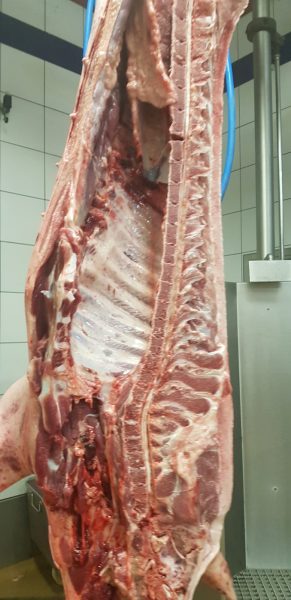COVID19 cases among slaughterhouse personnel
Lately, in fact, in recent months, some slaughterhouses and meat processing plants in many countries have been involved in outbreaks of COVID19, caused by SARSCoV2. What is special about these places?
To understand all this, we must remember how SARSCoV2 is transmitted. Strictly speaking it is not an airborne virus, i.e. it cannot travel tens of meters, riding on the air. It travels within drops – micro drops - over short or very short distances. The smaller the drop, the further it goes, but it obviously contains less virus, and is diluted in a larger volume of air. Therefore, the problem is said to be in the proximity because these droplets are still quite large and relatively concentrated around the emitter. And, in addition, since they are "heavy" they end up being deposited on the surfaces around the emitter: either asymptomatic, presymptomatic or symptomatic emitters that can hide their condition. This last concept is also important.
Slaughterhouses and meat processing facilities are places where people work very frequently in work chains, with the personnel very close to each other (it is unfeasible in most cases to keep the safety distance). Besides, they are noisy places, due to the machinery and the number of people working there, which often requires screaming rather than speaking. Remember that there are described cases of transmission by increasing the speed and radius of action of the emitted particles, which occurs when one, instead of speaking, shouts ... or sings, in a choir, for example (you can review this anecdotal but very illustrative case...). And remember that when you work in a chain you do not move much, to say the least, so you spend a lot of time with the same group of people over short distances.
Then add personal protection equipment (PPE), one might say. Correct, it is what should be done in a risk assessment once you have verified that all the previous measures are insufficient. Let us remember them, the other measures:
- Substitute the activity, which obviously cannot happen in this case.
- Add engineering or technical barriers, usually complicated in many of these spaces.
- Adopt organizational, procedural, and training measures (I must insist here, I am convinced that there is considerable room for improvement).
When all this is not enough, you must add the PPE.

Carcass inspection is performed in refrigerated facilities.
But PPE are not the panacea per se. People who have to use them must know HOW they are used, HOW they must be preserved or maintained. The company must know WHAT to buy, and that not EVERYONE can use the same PPE. This is evident in the case of masks, for example. Just as you will not wear a size S glove if you have a size L hand, there are face masks that will fit better or worse because your face is not standard. And putting on a mask is a barrier to your voice so maybe you will scream more. And remember that shifts can be long, 8-10-12 hours and that the production rate is high or very high in the chain; meat processing is an exhausting task, with obvious risks, intensive, which is very often carried out by personnel with little training and low wages. And that leads me to the near impossibility of properly keeping the PPE on all the time.
By the way, another exhausting, intensive task, carried out by personnel who usually have little formal training and also low wages and even undocumented workers, who at the end of their work gather on rooms full of other workers with rather "fair" conditions of spaces and services. It is the case of the seasonal workers (fruit collectors). In this case, the danger is not so much at work, but rather commuting to and from work (which can be done in packed shared vehicles) and in the rooms where they rest and sleep. And you know where other clusters are occurring lately.
As if this were not enough, the environmental conditions of these places are very favorable to the persistence of the virus ... environmentally speaking. Low temperatures, refrigeration in many cases, smooth and mostly non-porous surfaces, such as stainless steel, aluminum, plastic, described as favorable to the persistence of this coronavirus (and indeed of most viruses that I know of). Here are a few links to some articles related to persistence ... Chin and collaborators, van Doremalen and collaborators and Pastorino and collaborators, all of them referring to SARSCoV2 and published this year 2020.
COVID19 is not a foodborne disease. Meat is not affected in any way by the SARSCoV2 virus. Obviously, the meat does not carry viruses "per se" and the only way it reaches it is by contact with micro-drops exhaled by an infected person, whether he knows it or not, or by contact with surfaces previously contaminated by this infected carrier. It could also reach the meat if the transfer from one surface to the other (to the meat) were quite efficient, which for other viruses has been shown to be rather inefficient.
These clusters (grouped infections) become more evident at times of low virus circulation, as they stand out like a hill in the middle of a plain... it is perfectly possible that there had already been equivalent outbreaks 3 months ago, but camouflaged among the high incidence or general circulation of SARSCoV2 at that time. The mere concept of indoor grouping of personnel for a high number of hours is already an occupational risk... the rest of the factors that I have mentioned only increase it.
Perhaps the time has come to rethink many things.
But this, this is another story.
This entry has been written by Xavier Abad, virologist and head of the IRTA-CReSA High Biocontainement Unit . You can read more about it on his personal blog Commentaris viruslents.


1 comment(s)
Gracias, muy oportuno y enlaces muy esclarecedores.